Plant Science Research Weekly: March 1
Review: The metabolic response to drought ($)
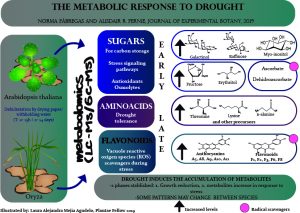 Understanding environmental stress in plants is undoubtedly important due to the consequences of climate change in crop productivity and survival of plants. Metabolomics based on liquid chromatography and gas chromatography coupled to mass spectrometry (LC-MS, GC-MS) allows an understanding of the metabolic profile changes of plants in response to stress. Fàbregas and Fernie review and compare the mechanisms that plants (Arabidopsis and rice) display in response to water stress (by dehydration or withholding water) using metabolic data from several independent studies. Drought stressed plants activate a series of responses including: the increase of sugars (as myo- inositol, raffinose, galactinol, mannose, glucose, among others) for supply of carbohydrates and for radical scavenging, increases in levels of amino acids (branched and aromatic), and increases in levels of flavonoids (anthocyanins and flavonols) as vacuole reactive oxygen species scavengers during the stress. The authors conclude, “Overall, metabolic data from independent studies reviewed herein show that drought generally induces the accumulation of primary metabolites.” (Summary by Laura Alejandra Mejía Agudelo) J. Exp. Bot. 10.1093/jxb/ery437
Understanding environmental stress in plants is undoubtedly important due to the consequences of climate change in crop productivity and survival of plants. Metabolomics based on liquid chromatography and gas chromatography coupled to mass spectrometry (LC-MS, GC-MS) allows an understanding of the metabolic profile changes of plants in response to stress. Fàbregas and Fernie review and compare the mechanisms that plants (Arabidopsis and rice) display in response to water stress (by dehydration or withholding water) using metabolic data from several independent studies. Drought stressed plants activate a series of responses including: the increase of sugars (as myo- inositol, raffinose, galactinol, mannose, glucose, among others) for supply of carbohydrates and for radical scavenging, increases in levels of amino acids (branched and aromatic), and increases in levels of flavonoids (anthocyanins and flavonols) as vacuole reactive oxygen species scavengers during the stress. The authors conclude, “Overall, metabolic data from independent studies reviewed herein show that drought generally induces the accumulation of primary metabolites.” (Summary by Laura Alejandra Mejía Agudelo) J. Exp. Bot. 10.1093/jxb/ery437
Review. Feeding the world: improving photosynthetic efficiency for sustainable crop production
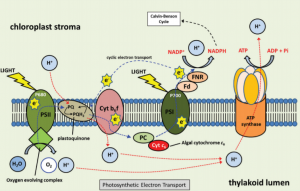 The global population is estimated to rise by 2 billion by 2050 placing strains on major food crops. To sustainably feed future populations and reduce the environmental damage of intensive agriculture, crop yields must be improved without increasing the amount of cultivatable land. In this review, Simkin et al. discuss recent progress of increasing crop biomass and seed yield through optimising photosynthetic efficiency. Successful transgenic manipulations of individual enzymes involved in photorespiration, electron transport and the Calvin-Benson cycle along with their implications for plant growth are examined. Multigene approaches are explored which can have both positive and negative effects for biomass accumulation depending on species and growth conditions. Improving photosynthetic efficiency alone is unlikely to satisfy the growing food demand and thus efforts should be made to optimise water and nitrogen use efficiency as well as responses to environmental stresses (Summary by Alex Bowles) J Exp Bot 10.1093/jxb/ery445.
The global population is estimated to rise by 2 billion by 2050 placing strains on major food crops. To sustainably feed future populations and reduce the environmental damage of intensive agriculture, crop yields must be improved without increasing the amount of cultivatable land. In this review, Simkin et al. discuss recent progress of increasing crop biomass and seed yield through optimising photosynthetic efficiency. Successful transgenic manipulations of individual enzymes involved in photorespiration, electron transport and the Calvin-Benson cycle along with their implications for plant growth are examined. Multigene approaches are explored which can have both positive and negative effects for biomass accumulation depending on species and growth conditions. Improving photosynthetic efficiency alone is unlikely to satisfy the growing food demand and thus efforts should be made to optimise water and nitrogen use efficiency as well as responses to environmental stresses (Summary by Alex Bowles) J Exp Bot 10.1093/jxb/ery445.
Metabolism gene prediction using diversiform molecular features
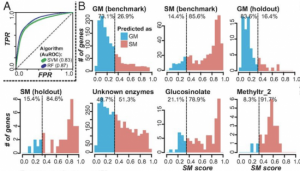 Advances in sequencing technologies enable scientists to obtain molecular features of genes in high-dimensionality. Features of individual gene like expression, methylation, histone modification, evolutionary signals and sequence itself provide high resolution for distinguishing annotated genes. In plant genomes the percentage of annotated genes with experimental evidence is low. In Moore et al., the authors classified Arabidopsis annotated genes as Specialized Metabolism (SM) or General Metabolism (GM). With the integration of 10,243 features, authors conducted machine learning algorithms, Random Forest and Support Vector Machine, to make predictions on identifying genes involved in GM or SM, resulting in “a prediction model … with a true positive rate of 87% and a true negative rate of 71%,” and also identified many genes with unknown function as having potential roles in SM. The study provides a framework on gene function prediction using accessible features from molecular level. (Summary by Zhikai Liang) PNAS 10.1073/pnas.1817074116
Advances in sequencing technologies enable scientists to obtain molecular features of genes in high-dimensionality. Features of individual gene like expression, methylation, histone modification, evolutionary signals and sequence itself provide high resolution for distinguishing annotated genes. In plant genomes the percentage of annotated genes with experimental evidence is low. In Moore et al., the authors classified Arabidopsis annotated genes as Specialized Metabolism (SM) or General Metabolism (GM). With the integration of 10,243 features, authors conducted machine learning algorithms, Random Forest and Support Vector Machine, to make predictions on identifying genes involved in GM or SM, resulting in “a prediction model … with a true positive rate of 87% and a true negative rate of 71%,” and also identified many genes with unknown function as having potential roles in SM. The study provides a framework on gene function prediction using accessible features from molecular level. (Summary by Zhikai Liang) PNAS 10.1073/pnas.1817074116
Evolutionary origins of pseudogenes and association with regulatory sequences
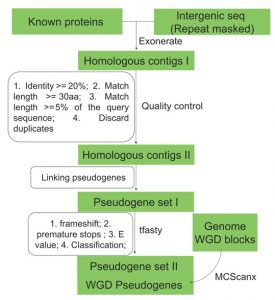 Protein-coding genes have undergone frameshifts, in-frame stop codons, and truncation to produce pseudogenes (Ψs), which had been thought to be non-functional. Recently, Ψs have been shown to play regulatory roles in gene expression by acting as a source of small interfering RNAs or sequestering microRNAs. Understanding the evolution and the molecular functions of Ψs will help to dissect the novel modules underlying Ψ-mediated regulatory network. In this context, Xie et al. have analyzed the origins of Ψs and their association with regulatory sequences in seven plant species, (Arabidopsis thaliana, Brachypodium distachyon, Glycine max, Medicago truncatula, Oryza sativa, Populus trichocarpa and Sorghum bicolor). The study found that Ψs are highly lineage-specific and have a high turnover rate, and their selective enrichment in the centromeric regions suggested the occurrence of Ψ elimination through genomic recombination. The active cis-regulatory elements in the promoter regions were found to produce a significant fraction of nonTE lncRNAs and nonTE miRNAs, thus opening an avenue for further studies to delineate the functions of these noncoding RNAs and the control of their expression. (Summary by Muthamilarasan Mehanathan) Plant Cell 10.1105/tpc.18.00601
Protein-coding genes have undergone frameshifts, in-frame stop codons, and truncation to produce pseudogenes (Ψs), which had been thought to be non-functional. Recently, Ψs have been shown to play regulatory roles in gene expression by acting as a source of small interfering RNAs or sequestering microRNAs. Understanding the evolution and the molecular functions of Ψs will help to dissect the novel modules underlying Ψ-mediated regulatory network. In this context, Xie et al. have analyzed the origins of Ψs and their association with regulatory sequences in seven plant species, (Arabidopsis thaliana, Brachypodium distachyon, Glycine max, Medicago truncatula, Oryza sativa, Populus trichocarpa and Sorghum bicolor). The study found that Ψs are highly lineage-specific and have a high turnover rate, and their selective enrichment in the centromeric regions suggested the occurrence of Ψ elimination through genomic recombination. The active cis-regulatory elements in the promoter regions were found to produce a significant fraction of nonTE lncRNAs and nonTE miRNAs, thus opening an avenue for further studies to delineate the functions of these noncoding RNAs and the control of their expression. (Summary by Muthamilarasan Mehanathan) Plant Cell 10.1105/tpc.18.00601
Site-specific manipulation of Arabidopsis loci using CRISPR-Cas9 SunTag systems
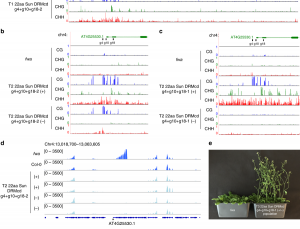 Steve Jacobsen’s group has been developing a broad range of synthetic biology tools to interrogate DNA-methylation in plants (see Gallego-Bartolomé et al., 2018, and Gallego-Bartolomé et al., 2019). Among them, they use the CRISPR-Cas9 SunTag system, in which the dCas9 protein is fused to SunTag, a repetitive peptide epitope. In combination with a guide RNA, this system allows for antibody-based recruitment of multiple copies of effectors. In this work by Papikian et al., they use it to recruit the VP64 transcriptional activator for locus-specific activation, or the DRM methyltransferase for locus-specific DNA-methylation. Although this method can increase the target gene’s transcript levels, it is not always enough to trigger a significant phenotype. In the same way, targeted DNA-methylation also initially presented some limitations of specificity and inheritability. However, the authors provide ways to overcome these problems and achieve desirable outputs (e.g., more gRNA, or by altering SunTag linker length, or effector nuclear localization signals). This paper is a good example of how a thorough analysis within a design-build-test-learn cyclic framework helps to the understanding of a technology and the observation of interesting phenomena. CRISPR-Cas9-SunTag system is a versatile expansion to the plant CRISPR toolbox. (Summary by Facundo Romani) Nature Comms. 10.1038/s41467-019-08736-7
Steve Jacobsen’s group has been developing a broad range of synthetic biology tools to interrogate DNA-methylation in plants (see Gallego-Bartolomé et al., 2018, and Gallego-Bartolomé et al., 2019). Among them, they use the CRISPR-Cas9 SunTag system, in which the dCas9 protein is fused to SunTag, a repetitive peptide epitope. In combination with a guide RNA, this system allows for antibody-based recruitment of multiple copies of effectors. In this work by Papikian et al., they use it to recruit the VP64 transcriptional activator for locus-specific activation, or the DRM methyltransferase for locus-specific DNA-methylation. Although this method can increase the target gene’s transcript levels, it is not always enough to trigger a significant phenotype. In the same way, targeted DNA-methylation also initially presented some limitations of specificity and inheritability. However, the authors provide ways to overcome these problems and achieve desirable outputs (e.g., more gRNA, or by altering SunTag linker length, or effector nuclear localization signals). This paper is a good example of how a thorough analysis within a design-build-test-learn cyclic framework helps to the understanding of a technology and the observation of interesting phenomena. CRISPR-Cas9-SunTag system is a versatile expansion to the plant CRISPR toolbox. (Summary by Facundo Romani) Nature Comms. 10.1038/s41467-019-08736-7
Dual regulation of Arabidopsis AGO2 by arginine methylation
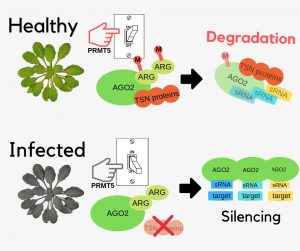 Plants have natural mechanisms against pathogen infections. Post-translational modifications (PTMs) on key proteins involved in RNAi pathways are needed to control these immune responses. Argonaute (AGO) proteins are targets of PTMs to direct the silencing of genes. Here, Hu et al. identified the role of PRMT5, an arginine methyltransferase, in directing symmetric dimethylation in the N-terminal of Arabidopsis AGO2 by using coimmunoprecipitation coupled with mass spectroscopy analysis and bimolecular fluorescence complementation in mutants. This methylation leads to AGO2 degradation by 26S proteasome. Meanwhile, the methylarginine residues interacts with Tudor-domain proteins (TSNs) which also have degradation activity controlling abundance of AGO2 associated small RNAs. With these results, the authors suggest that in bacterial infected plants, PRMT5 is downregulated increasing the levels of AGO2 and its bound sRNAs and contributing to increased host immunity. Further studies of post-translational modifications on RNAi pathways may be useful for the development of pathogen-resistant crop varieties. (Summary by Ana Valladares) Nature Comms s41467-019-08787-w
Plants have natural mechanisms against pathogen infections. Post-translational modifications (PTMs) on key proteins involved in RNAi pathways are needed to control these immune responses. Argonaute (AGO) proteins are targets of PTMs to direct the silencing of genes. Here, Hu et al. identified the role of PRMT5, an arginine methyltransferase, in directing symmetric dimethylation in the N-terminal of Arabidopsis AGO2 by using coimmunoprecipitation coupled with mass spectroscopy analysis and bimolecular fluorescence complementation in mutants. This methylation leads to AGO2 degradation by 26S proteasome. Meanwhile, the methylarginine residues interacts with Tudor-domain proteins (TSNs) which also have degradation activity controlling abundance of AGO2 associated small RNAs. With these results, the authors suggest that in bacterial infected plants, PRMT5 is downregulated increasing the levels of AGO2 and its bound sRNAs and contributing to increased host immunity. Further studies of post-translational modifications on RNAi pathways may be useful for the development of pathogen-resistant crop varieties. (Summary by Ana Valladares) Nature Comms s41467-019-08787-w
Cell geometry determines symmetric and asymmetric division plane selection in Arabidopsis early embryos
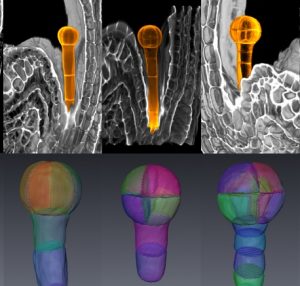
Cells proliferate via symmetric divisions while asymmetric divisions are associated with new cell types, layers and developmental patterns. The correct orientation of cell divisions planes is required for plant tissue architecture and organ morphogenesis. In plants, previous attempts to predict division planes from cell geometry were mostly focused on 2D symmetric divisions. Julien et al. combined a 3D quantitative image analysis and a 3D cell division model in order to study the existence and nature of rules governing cell divisions in plant embryos. Using their model, they revealed a new rule for predicting the position and the orientation of division planes from mother cell geometries, good for both symmetric and asymmetric cell divisions. Their results point out the importance for a geometrical feedback loop between cell geometry and division plane selection in the self-organization of the plant early embryogenesis. Their data further suggest the rule can be interpreted based on the nucleus position and the dynamics of the cytoskeleton. (Summary by Francesca Resentini) PLOS Comp. Biol. 10.1371/journal.pcbi.1006771
Two novel repressors of photomorphogenesis act downstream of HY5 in Arabidopsis
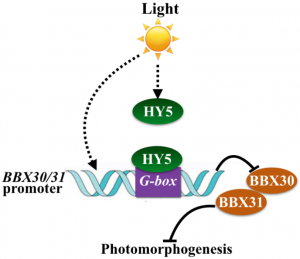 Higher plants rely on a sophisticated photo-sensory system to cope with the vast variety of environmental stimuli. Under light conditions, young seedlings display photomorphogenic development to maxize the usage of light. Recently, YQ Heng et al. discovered two B-box containing proteins, BBX30 and BBX31, can repress photomorphogenesis in Arabidopsis. The central positive regulator ELONGATED HYPOCOTYL 5 (HY5) directly binds the G-box present in their promoters to prevent their transcription. Since HY5 is well-known for controlling numerous positive regulator of light signaling to boost photomorphogenesis, this study shows that HY5 is also capable of inhibiting the function of negative regulators of light signaling, suggesting higher plants coordinate an antagonistic regulatory machinery that controls plant photomorphogenesis. (Summarized by Nanxun Qin) Plant Physiol. 10.1104/pp.18.01244
Higher plants rely on a sophisticated photo-sensory system to cope with the vast variety of environmental stimuli. Under light conditions, young seedlings display photomorphogenic development to maxize the usage of light. Recently, YQ Heng et al. discovered two B-box containing proteins, BBX30 and BBX31, can repress photomorphogenesis in Arabidopsis. The central positive regulator ELONGATED HYPOCOTYL 5 (HY5) directly binds the G-box present in their promoters to prevent their transcription. Since HY5 is well-known for controlling numerous positive regulator of light signaling to boost photomorphogenesis, this study shows that HY5 is also capable of inhibiting the function of negative regulators of light signaling, suggesting higher plants coordinate an antagonistic regulatory machinery that controls plant photomorphogenesis. (Summarized by Nanxun Qin) Plant Physiol. 10.1104/pp.18.01244
Root xylem formation and vascular acclimation to water deficit involves endodermal ABA signaling via miR166 ($)
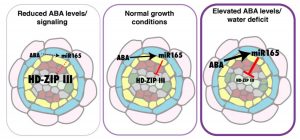 Abiotic stress influences plant development, with the phytohormone ABA playing an important role. Ramachandran et al. have demonstrated ABA mediated activation of microRNA 166, which regulates expression levels of the HD-ZIP III transcriptional factor family. Exogenously supplied ABA alters xylem patterning due to a change in cell fate, as demonstrated using xylem cell-type specific markers. Previous work has shown that miR166 acts in a gradient from the endodermis towards the center of root stele and this study suggests that such non-cell autonomous signaling could be influenced by ABA levels. In addition to exogenous ABA treatment assays, the plants were subjected to water deficit condition, which causes an increase in endogenous ABA levels. Under this drought-like condition a similar change in xylem patterning was observed. These results suggests that ABA can influence root xylem architecture by altering miR166 and HD-ZIP III levels. (Summary by Suresh Damodaran) Development 10.1242/dev.159202
Abiotic stress influences plant development, with the phytohormone ABA playing an important role. Ramachandran et al. have demonstrated ABA mediated activation of microRNA 166, which regulates expression levels of the HD-ZIP III transcriptional factor family. Exogenously supplied ABA alters xylem patterning due to a change in cell fate, as demonstrated using xylem cell-type specific markers. Previous work has shown that miR166 acts in a gradient from the endodermis towards the center of root stele and this study suggests that such non-cell autonomous signaling could be influenced by ABA levels. In addition to exogenous ABA treatment assays, the plants were subjected to water deficit condition, which causes an increase in endogenous ABA levels. Under this drought-like condition a similar change in xylem patterning was observed. These results suggests that ABA can influence root xylem architecture by altering miR166 and HD-ZIP III levels. (Summary by Suresh Damodaran) Development 10.1242/dev.159202
Cuticle is found in the root! The root cap cuticle protects young roots from abiotic stress and helps lateral root outgrowth ($)
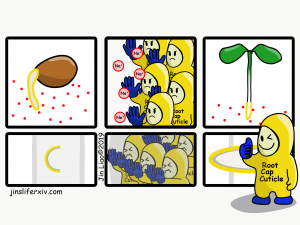 To adapt to life on land, plants developed lipid-derived modifications on the surface of aerial organs (shoot). The cuticle forms a multi-layered structure of lipid components at the outermost surface of the organ to protect plant cells from environment stresses. Roots, as the organ specialized for the acquisition of water and nutrients, were thought to have no cuticle, as it might prevent absorption Here, Berhin et al. presented a breakthrough discovery that cuticle also exists in root. Using histological, chemical, and genetic approaches, they showed a previously unrecognized root cap cuticle (RCC) on the first cell layer of the root cap of the primary root and in lateral root primordia. Their findings reveal the role for root caps in early developmental stage and demonstrate that the RCC plays similar physiological roles as the cuticle of the shoot. (Summary by Jin Liao) Cell 10.1016/j.cell.2019.01.005
To adapt to life on land, plants developed lipid-derived modifications on the surface of aerial organs (shoot). The cuticle forms a multi-layered structure of lipid components at the outermost surface of the organ to protect plant cells from environment stresses. Roots, as the organ specialized for the acquisition of water and nutrients, were thought to have no cuticle, as it might prevent absorption Here, Berhin et al. presented a breakthrough discovery that cuticle also exists in root. Using histological, chemical, and genetic approaches, they showed a previously unrecognized root cap cuticle (RCC) on the first cell layer of the root cap of the primary root and in lateral root primordia. Their findings reveal the role for root caps in early developmental stage and demonstrate that the RCC plays similar physiological roles as the cuticle of the shoot. (Summary by Jin Liao) Cell 10.1016/j.cell.2019.01.005
New approaches to optimize somatic embryogenesis in maritime pine
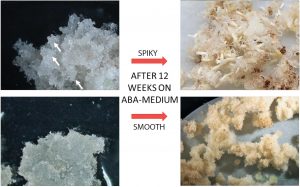 Pinus pinaster Aiton, commonly known as maritime pine, is a coniferous tree, native to the Mediterranean region, and presently used as a model plant when studying coniferous trees due to the interest in its environmental adaptability. Maritime pine breeding programs use somatic embryogenesis, a biotechnological process in which a plant embryo is derived from a somatic plant cell, as the common tool to produce elite cultivars. In order to increase success during the induction and maturation phases, Arrillaga et al. analyzed the possible maternal influence (i.e., the impact of the female donor in controlled crosses) on the embryogenic capability of megagametophytes, as well as other more common environmental variables. (Summary by Isabel Mendoza) Front. Plant Sci. 10.3389/fpls.2019.00138
Pinus pinaster Aiton, commonly known as maritime pine, is a coniferous tree, native to the Mediterranean region, and presently used as a model plant when studying coniferous trees due to the interest in its environmental adaptability. Maritime pine breeding programs use somatic embryogenesis, a biotechnological process in which a plant embryo is derived from a somatic plant cell, as the common tool to produce elite cultivars. In order to increase success during the induction and maturation phases, Arrillaga et al. analyzed the possible maternal influence (i.e., the impact of the female donor in controlled crosses) on the embryogenic capability of megagametophytes, as well as other more common environmental variables. (Summary by Isabel Mendoza) Front. Plant Sci. 10.3389/fpls.2019.00138
ABC transporter-mediated transport of glutathione conjugates enhances seed yield and quality in chickpea
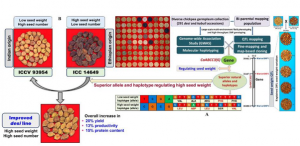 Identifying the genetic determinants of yield and quality traits is essential for crop improvement. Chickpea is the third-most cultivated legume species and is a prominent source of protein to global consumers. Genetic improvement of chickpea, in terms of enhancing its seed size and weight, has been impeded as the QTLs and genes identified so far are not robust enough to regulate these traits across diverse genetic backgrounds and environments. In this new work, Basu et al. have deployed an integrated approach of molecular genetics, functional genomics and genomics-assisted breeding to identify an ABCC3-type ATP binding cassette (ABC) transporter gene that regulates seed size as well as weight in chickpea. An association panel consisting of 291 diverse chickpea accessions representing both desi (189) and kabuli (102) cultivar groups were phenotyped for pod number, seed number and weight traits for three consecutive years. Genome-wide association mapping revealed an association of a synonymous SNP in ABCC3(6) with seed weight; furthermore, introgressing ABCC3(6) in near-isogenic lines (NILs) improved seed weight. Further analysis showed that ABCC3(6) modulates glutathione conjugate transport to enhance seed weight. (Summary by Muthamilarasan Mehanathan) Plant Physiol. 10.1104/pp.18.00934
Identifying the genetic determinants of yield and quality traits is essential for crop improvement. Chickpea is the third-most cultivated legume species and is a prominent source of protein to global consumers. Genetic improvement of chickpea, in terms of enhancing its seed size and weight, has been impeded as the QTLs and genes identified so far are not robust enough to regulate these traits across diverse genetic backgrounds and environments. In this new work, Basu et al. have deployed an integrated approach of molecular genetics, functional genomics and genomics-assisted breeding to identify an ABCC3-type ATP binding cassette (ABC) transporter gene that regulates seed size as well as weight in chickpea. An association panel consisting of 291 diverse chickpea accessions representing both desi (189) and kabuli (102) cultivar groups were phenotyped for pod number, seed number and weight traits for three consecutive years. Genome-wide association mapping revealed an association of a synonymous SNP in ABCC3(6) with seed weight; furthermore, introgressing ABCC3(6) in near-isogenic lines (NILs) improved seed weight. Further analysis showed that ABCC3(6) modulates glutathione conjugate transport to enhance seed weight. (Summary by Muthamilarasan Mehanathan) Plant Physiol. 10.1104/pp.18.00934
The volatile indole primes rice defense against caterpillar attack
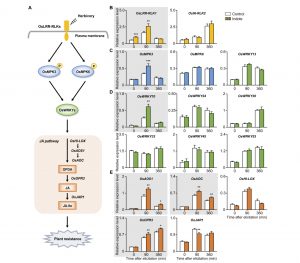 Herbivore-induced volatiles have been shown to prime plant defense response in multiple species. A new study by Ye et al. unveils some of the early signaling events in volatile-mediated defense priming in rice. The authors show that rice plants release increased amounts of the volatile indole when attacked by fall armyworm caterpillars. Indole pre-exposure induces expression and/or activity of several genes in early defense signaling pathways upon simulated herbivore attack. Among these, activation of a MAP kinase gene (OsMPK3) triggers increased jasmonate biosynthesis. Silencing of this gene reduces indole-primed herbivore resistance in rice plants. The authors conclude that rather than directly affecting caterpillar physiology, indole enhances rice resistance to caterpillar attack through priming of jasmonate-based defense signaling. (Summary by Saima Shahid) Plant Cell 10.1105/tpc.18.00569.
Herbivore-induced volatiles have been shown to prime plant defense response in multiple species. A new study by Ye et al. unveils some of the early signaling events in volatile-mediated defense priming in rice. The authors show that rice plants release increased amounts of the volatile indole when attacked by fall armyworm caterpillars. Indole pre-exposure induces expression and/or activity of several genes in early defense signaling pathways upon simulated herbivore attack. Among these, activation of a MAP kinase gene (OsMPK3) triggers increased jasmonate biosynthesis. Silencing of this gene reduces indole-primed herbivore resistance in rice plants. The authors conclude that rather than directly affecting caterpillar physiology, indole enhances rice resistance to caterpillar attack through priming of jasmonate-based defense signaling. (Summary by Saima Shahid) Plant Cell 10.1105/tpc.18.00569.



